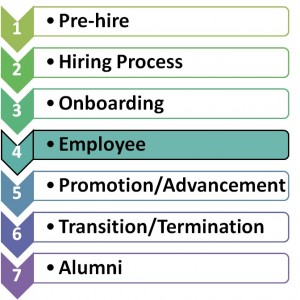![]() In the 7 Phases of Engagement, I proposed that each phase ties directly to the employee lifecycle and has the potential to impact the success of a company in terms of its ability to engage employees.
In the 7 Phases of Engagement, I proposed that each phase ties directly to the employee lifecycle and has the potential to impact the success of a company in terms of its ability to engage employees.
Today, we’ll look at the fourth phase of engagement: Employee Engagement.
Employee engagement is a broad topic. This post is meant to give you an overview of what goes into employee engagement efforts. It isn’t meant to be an exhaustive discussion.
What is Employee Engagement?
In “Are you an Agent in Engagement?,” one of the first Agent In Engagement blog posts, I provided a few of the employee engagement definitions that resonated with me.
- Forrester Research defines employee engagement using three criteria:1
- A deep emotional connection with the brand
- High levels of active participation
- A long-term relationship
- Kevin Kruse defines employee engagement as “the emotional commitment the employee has to the organization and its goals.” 2
- Leigh Branham and Mark Hirschfeld define employee engagement as “a heightened emotional and intellectual connection that an employee has for his or her job, organization, manager, or co-workers that, in turn, influences him or her to apply additional discretionary effort to his or her work.” 3
Why is Employee Engagement Important?
According to Gallup’s State of the American Workplace Survey, 70% of all employees are either “Not Engaged” or “Actively Disengaged;” only 30% are “Engaged.” Here are a few examples of why employee engagement is important and how it has the potential to positively impact a company’s success:
- “’Actively Disengaged’ employees aren’t just unhappy at work; they’re busy acting out their unhappiness. Each day, these workers undermine what their engaged coworkers accomplish.”4
- Experts predict the current turnover rate may rise to 65%. With recruiting costs running approximately 1.5 times annual salary, the ability to engage and retain valuable employees has a significant impact on an organization’s bottom line.5
- Gallup’s research also shows that companies with engaged workforces have higher earnings per share (EPS), and they seem to have recovered from the recession at a faster rate. 6
What Are Some Factors of Employee Engagement?
Managers Make the Biggest Impact
Gallup has found that managers who focus on their employees’ strengths can practically eliminate active disengagement and double the average of U.S. workers who are engaged nationwide.7 To most employees, managers are the company. Managing others requires talent. Unfortunately, not every manager has that talent. Most managers are promoted based on their work outcomes rather than on their ability to care for employees and help them succeed. Companies need to select the right managers, continually coach them on providing recognition/feedback and hold them accountable for developing their direct reports.
Recognition/ Feedback is Important
Recent studies have shown that when employees are consistently recognized in ways that are meaningful to them, they are significantly more likely to align their work activities with organizational priorities.8
Employees Want Development
Career development opportunities are an essential part of employee engagement. In fact, key driver analyses consistently show that career development is the second most impactful way of increasing employee engagement, after recognition.9The research shows that people who use their strengths every day are six times more likely to be engaged on the job.10 Managers should be helping their direct reports understand and develop their strengths as well as help them understand how to better apply them in the workplace. Continual learning within and outside of the organization should be encouraged.
Typical Programs Used in Engagement
Most companies rely on a few formal programs to engage their employees. While these can impact engagement, I believe the main focus should stay on managers, recognition and development opportunities.
Health & Well-being Programs
Many companies offer Health & Well-being program but do a poor job of promoting them to employees. Health plans are the best known of these programs. Their complexity causes some employees to miss out on available benefits. Employee Assistance Programs (EAP) are popular as well. Often managed by an outside company, an ESP helps connect employees with resources in time of need. Some companies offer smoking cessation classes, weight control classes, fitness challenges, book clubs, sports teams, etc. The goal is to help connect employees to the company while helping the employees reach their personal goals.
Employee Giving Campaigns/ Volunteerism
Larger companies tend to promote community involvement. This can take the form of an annual employee giving campaign, matching donations, or community volunteer opportunities.
Mentoring Programs
Some companies set up formal mentoring programs that match employees with company leaders. Their success depends on the participants themselves.
How is Employee Engagement Measured?
Companies often use employee surveys on an annual or bi-annual basis to collect data on engagement. Question selection and wording is critical to remove any bias from these surveys. Often lengthy and time-consuming to analyze, most companies fail to deeply analyze and extract meaningful information from them and fail to report the findings to employees in a meaningful way. Recently, pulse surveys have become popular as a way to reduce the number of questions and allow for quicker analysis of the findings. See Big Data opportunities below.
New Ways to Engage
There are a couple of interesting opportunities to focus on engagement that are gaining in popularity.
Gamification
Some companies are turning to gamification as a way to engage their employees while targeting a specific business objective. University of Pennsylvania – Wharton Professor Kevin Werbach defines gamification as the use of game elements and game design techniques in non-game contexts. The purpose is to make work fun while achieving business objectives.
Gamification is beginning to reach a critical mass. To learn more, visit www.Gamication.co. The site is hosted by Gabe Zichermann, a Brooklyn-based expert that travels the world lecturing on gamification. It is packed with free content, provides information on the annual Gamification Summit, and offers a weekly 30-minute Gamification Revolution webcast which features leaders in the field.
Big data opportunities
As we’ve learned from the NSA (National Security Administration)leaks, information about each of us is being collected continuously. Companies are no different and have servers full of collected data. Organizations need to better utilize this information in order to understand and predict the critical drivers of engagement and performance. This deep insight can help a company achieve a competitive advantage.
Time to Engage!
I began my journey into employee engagement when I developed and taught a 10-week course focused on improving customer service. I’ve witness what employee engagement can do for both employees and companies. I encourage you to read some of the past Agent In Engagement posts to learn how you can jumpstart employee engagement in your organization.
1 Forrester Research, Inc. “How Engaged Are Your Customers?” Adobe. Sep. 2008. Web. 8 Apr 2014. http://www.adobe.com/engagement/pdfs/Forrester_TLP_How_Engaged_Are_Your_Customers.pdf
2 Kruse, Kevin. (2013) Employee Engagement for Everyone: 4 Keys to Happiness and Fulfillment at Work. Philadelphia: The Center for Wholehearted Leadership. p.6
3 Branham, Leigh and Mark Hirschfeld. (2010) Re-engage: How America’s Best Places to Work Inspire Extra Effort in Extraordinary Times. McGraw Hill.
4 O’Boyle, Ed and Jim Harter. “State of the American Workplace Survey.” Gallup, Inc. 2013. Web. 8 Apr 2014. p.21
5 “WHAT DRIVES EMPLOYEE ENGAGEMENT AND WHY IT MATTERS” Dale Carnegie. 2012. Web. 8 Apr 2014. p.4 http://www.dalecarnegie.com/assets/1/7/driveengagement_101612_wp.pdf
6 Sorenson, Susan. “How Employee Engagement Drives Growth.” Gallup Business Journal. 20 Jun 2013. Web. 8 Apr 2014.
7 O’Boyle, Ed and Jim Harter. “State of the American Workplace Survey.” Gallup, Inc. 2013. Web. 8 Apr 2014. p.9
8 “Engagement Scores Double When People Are Consistently and Meaningfully Recognized.” Maritz Motivation. Web. 8 Apr 2014. http://www.maritzmotivation.com/Employee-Recognition.aspx
9 Conrad, Sean. “Career Development is Key to Increasing Employee Engagement.” Halogen Software Blog. 21 Oct 2013. Web., 8 Apr 2014. http://www.halogensoftware.com/blog/career-development-is-key-to-increasing-employee-engagement
10 O’Boyle, Ed and Jim Harter. “State of the American Workplace Survey.” Gallup, Inc. 2013. Web. 8 Apr 2014. p.46
P.S. First time here? Welcome to the Agent In Engagement site. Thanks for taking the time to stop by! I hope you’ll explore the rest of the site. Let me know what employee engagement topics interest you.
If you enjoyed this article, you may also like…
- Onboarding: The Third Phase of Engagement
- Hiring Process: The Second Phase of Engagement
- Pre-hire: The First Phase of Engagement
- 7 Phases of Engagement
- Take the Day On – March Forth!
- Engaging Through The Infographic
Let’s Get Engaged!
I’m Agent in Engagement Simpson…Gregory F Simpson.
I’m excited about this opportunity to connect with fellow “Agents.” Subscribe to the RSS Feed to receive the latest updates and/or register to comment on posts.
 You can follow me @agtinengagement.
You can follow me @agtinengagement.
Email me at g…@a…t.com.
Learn more about me at www.gregoryfsimpson.com.
